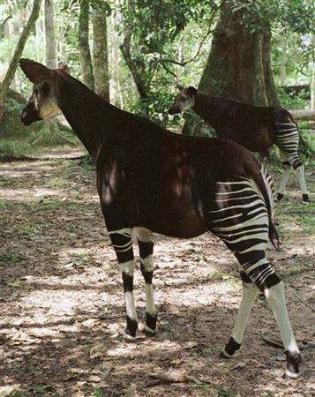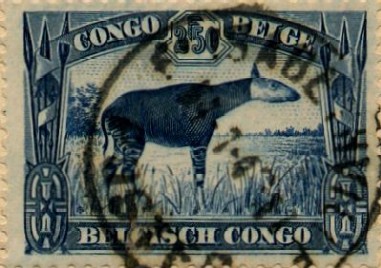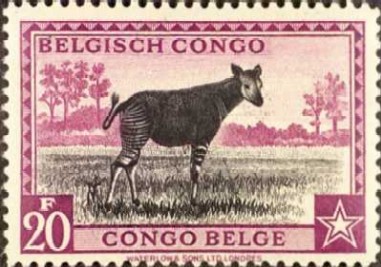
June 9, 2006
Thought extinct for 47 years in the Congo’s Virunga National Park, the okapis have been rediscovered!

Okapis are important in the history of romantic natural history. The animal was used to symbolize the International Society of Cryptozoology (1982-1995), and was the centerpiece of the organization’s logo.
The okapi (Okapia johnstoni) is a beautiful animal, a true “living fossil”. I have observed them in St. Louis, Chicago, San Diego, and every zoo I can find that has any. Last weekend, I was able to observe for several minutes over the space of three hours, the 21-year-old male, born in the San Diego Zoo, and now in captivity at the San Antonio Zoo. Zookeepers Charlene and Ramone were kind enough to discuss the specimen with me, and Ramone even engaged (via petting and feeding) and coaxed the animal to be a little less shy about starting its morning routine, before I left for Maine. Unnecessary but appreciated.

For years in the 19th century, Europeans brushed aside tales from the native peoples of the Congo, the pygmies, about a creature said to look like a cross between a zebra and a giraffe. That would all change at the turn of the twentieth century. Sir Harry Johnston gained the trust of a band of Congolese pygmies when he rescued them from a German showman who was trying to abduct and show them at the 1900 Paris Exhibition.
Johnston then began hearing stories from them about the okapi, a mule-sized animal animal with zebra stripes. In 1901, Johnston secured and sent a whole skin, two skulls, and a detailed description of the okapi to London. First found in what is now the Virunga in the eastern Democratic Republic of Congo in 1901, the okapis were thought to have died out, nevertheless in recent years, in the very site of their discovery.

Now, on Friday, June 9, 2006, an announcement has been made that conclusive proof of the existence of okapis in the Congo’s Virunga National Park has been confirmed. This re-discovery of these animals is a remarkable story of survival, as they have not been found there since 1959. A recent survey of the area by conservation group World Wildlife Fund (WWF) and the Institut Congolais pour la Conservation de la Nature (ICCN) found 17 okapi tracks and other evidence of its presence. No sightings of the elusive animal were documented but its tracks were taken as “absolute proof of the creature’s recent activity in the park,” reported Reuters.
“The rediscovery of okapis in Virunga National Park is a positive sign,” said Marc Languy, of WWF’s Eastern Africa Regional Programme. “As the country is returning to peace, it shows that the protected areas in this troubled region are now havens for rare wildlife once more. Except for mountain gorillas, which have shown an increase in population due to important conservation efforts, most wildlife in the park (Virunga) have heavily suffered from poaching. The population of hippopotamus, for example, has dropped from 29,000 in the mid-1970s to less than 1,000 today,” Languy commented.
This is good news to hear about the okapis.
About Loren Coleman
Loren Coleman is one of the world’s leading cryptozoologists, some say “the” leading living cryptozoologist. Certainly, he is acknowledged as the current living American researcher and writer who has most popularized cryptozoology in the late 20th and early 21st centuries.
Starting his fieldwork and investigations in 1960, after traveling and trekking extensively in pursuit of cryptozoological mysteries, Coleman began writing to share his experiences in 1969. An honorary member of Ivan T. Sanderson’s Society for the Investigation of the Unexplained in the 1970s, Coleman has been bestowed with similar honorary memberships of the North Idaho College Cryptozoology Club in 1983, and in subsequent years, that of the British Columbia Scientific Cryptozoology Club, CryptoSafari International, and other international organizations. He was also a Life Member and Benefactor of the International Society of Cryptozoology (now-defunct).
Loren Coleman’s daily blog, as a member of the Cryptomundo Team, served as an ongoing avenue of communication for the ever-growing body of cryptozoo news from 2005 through 2013. He returned as an infrequent contributor beginning Halloween week of 2015.
Coleman is the founder in 2003, and current director of the International Cryptozoology Museum in Portland, Maine.
Filed under Breaking News, Cryptotourism, CryptoZoo News, Cryptozoology, Extinct, Eyewitness Accounts, Forensic Science